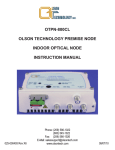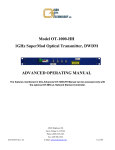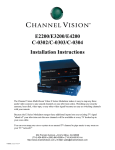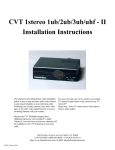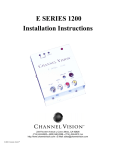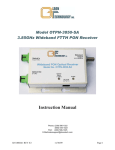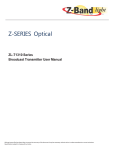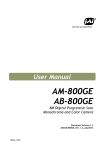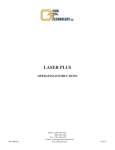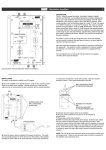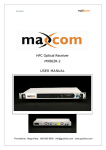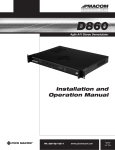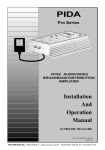Download OTPN-800CH - Olson Technology Inc.
Transcript
OTPN-800CH OLSON TECHNOLOGY PREMISE NODE INDOOR OPTICAL NODE INSTRUCTION MANUAL 025-000493 Rev X6 Phone: (209) 586-1022 (800) 545-1022 Fax: (209) 586-1026 E-Mail: [email protected] www.olsontech.com 10/07/10 SAFETY WARNINGS LASER RADIATION The OTPN-800CH may be equipped with a laser transmitter which emits invisible radiation that can cause permanent eye damage. AVOID DIRECT EXPOSURE TO BEAM. Operate the transmitter only with the proper optical fiber installed in the transmitter optical connector. Power to the OTPN-800CH should be turned-off or preferably, disconnected whenever the optical connector cover is opened and there is no installed fiber (as when the fiber connector is being installed or removed from the transmitter connector). NEVER USE ANY OPTICAL INSTRUMENT TO VIEW THE OUTPUT OF THE LASER TRANSMITTER. “OPTICAL INSTRUMENT” INCLUDES MAGNIFYING GLASSES, ETC. NEVER LOOK INTO THE OUTPUT OF THE LASER TRANSMITTER NEVER LOOK INTO THE OUTPUT OF A FIBER CONNECTED TO A LASER TRANSMITTER. NEVER LOOK INTO OR USE ANY OPTICAL INSTRUMENT TO VIEW THE DISTANT END OF A FIBER THAT MAY BE CONNECTED DIRECTLY OR VIA AN OPTICAL SPLIT, TO A TRANSMITTER THAT MAY BE OPERATING. THIS SPECIFICALLY APPLIES TO FIBERS THAT ARE TO BE CONNECTED TO RECEIVERS (SUCH AS THE OTPN-800CH) OR OTHER DEVICES AT ANY DISTANCE FROM THE LASER TRANSMITTER. HIGH VOLTAGE The power supply section (bottom section) of the OTPN-800CH contains no user serviceable parts. There is exposed high voltage inside this section. Only factory service technicians should open the power supply section. SHOCK HAZARD The OTPN-800CH is designed for indoor use only. Direct exposure to moisture must be avoided. Connect the AC Adapter into the OTPN-800CH BEFORE plugging the adapter into the wall. INTRODUCTION The OTPN-800CH is a high-quality, cost-effective, bidirectional CATV node designed around the latest optical receiver technology. It is designed to operate and meet full specifications with optical input levels ranging from -8dBm to +2dBm. The receive RF path includes provisions for plug-in equalizers to provide for sloped output response as well as user adjustable padding to set the forward and reverse RF gains. The OTPN800CH is available with three different band splits; 1) 5-42/54-1,000MHz, 2) 5-30/451,000MHz, 3) 5-65/85-1,000MHz The OTPN-800CH can be equipped with an optional return laser transmitter. An AC adapter is with an input range of 100-240VAC, 50/60Hz is supplied with each unit. INSTALLATION / ENVIRONMENTAL CONSIDERATIONS The OTPN-800CH is specified to operate from -10°C to +55°C. It should be mounted in an adequately ventilated area. Like any other electronic equipment, it will probably have a longer life span if it is not operated at the upper limit of the temperature range. Installation in wet areas or areas of extremely high humidity should be avoided. The OTPN-800CH should not be installed in areas that are accessible to children. The OTPN-800CH may be installed and operated in any position on a flat surface. The unit has two slots in the bottom plate to accommodate mounting hardware. The unit should be mounted by sliding over one screw and then tightening the other screw. If mounting requires a wood screw, use #6 or #8 (maximum) pan-head sheet metal screws. If mounting with a machine screw (to tapped holes), use 6-32 pan-head screws. Figure 1 - OTPN-800CH Inputs and Outputs OPTICAL CONNECTORS AND CLEANING The standard optical connector is available in SC/APC or FC/APC type terminations. The left port is for the forward band receiver. The right port closest is for use with the return band transmitter. The fiber ends can be damaged by the insertion of contaminated connectors. Some types of customer damage to connectors are not covered under warranty. Fiber connectors should never be left uncovered. Prepackaged alcohol wipes are the most convenient means of cleaning optical connectors. Clean alcohol and lint free wipes or swabs may also be used. POWERING Apply only +12 VDC to either the “F” connector closest to the top cover of the unit, or through a power inserter in series with the Main RF output connector, the “F” connector closest to the outside edge of the housing. NOTE: The center conductor of the “F” connector is “+” and the shield is ground. OPERATIONAL SETUP - RECEIVER (FORWARD PATH) The OTPN-800CH optical receiver as the last component in a specific optical link will provide carrier-to-noise performance and an RF output level that is dependent on several parameters. The RF input level to the source optical transmitter and the optical input level to the OTPN-800CH basically determine the link performance. The optimum RF input level to any optical transmitter is dependent on the number of channels being transmitted. As the number of carried channels is lowered, the RF input level to the transmitter can be raised. This results in increased RF levels at the OTPN800CH receiver. This improves the carrier-to-noise ratio over the link. Links should be designed and transmitters should be set up using values that represent the maximum number of channels likely to be carried. The receiver output power is also affected by the amount of equalization used. The use of a lower value equalizer will require reducing the output level as measured at the highest channel. This is because the attenuation of the lower channels is reduced. Table 1 assumes approximately 77 channels from 54MHz to 550MHz and digital loading from 550MHz to 1,000MHz at -6 dB below the carrier. The OTPN-800CL does not have a forward equalizer, and therefore has 0dB of slope (flat). This unit is designed to work with short coax runs. Extended lengths of coax will cause down sloping (lower RF level) of higher frequencies. Table 1 - Setup Reference Although the node will operate at optical input levels as high as +2dBm, there is little improvement in the CNR performance of the node at optical input levels above 0 dBm. For optimum distortion performance, it is recommended that the optical input to the node be kept at or below 0 dBm. The Olson Technology Model OTOA-1000 optical attenuator is ideal for this application. To lower the output level the adjustable pad should be increased but a reduction below +38dBmV output at 547.25 MHz by this method is not recommended. If lower output is desired, the unit should be set for +35dBmV and an in-line pad added to the RF output to reduce the output level. This will maintain optimum CNR performance. This will also reduce the OMI of the return transmitter if so equipped. Unlike many optical nodes, the OTPN-800CH is designed to give full output performance at an input of -8 dBm. Figure 1 shows the approximate CNR performance at various input levels and channel loading. This performance can vary considerably depending upon fiber and laser performance so it is presented as a design aid only. The OTPN-800CH ships with an 10dB forward equalizer which gives 6dB of slope from 54-1,000 MHz. This can be changed by the user to vary the amount of slope that the unit has. A higher value equalizer will give more slope, while a lower value equalizer will give less slope. This is so that the unit can be properly setup for the amount of coax that the output will be going through. Longer distances require more slope then shorter distances. Figure 2 - Typical CNR vs. Optical Input Level INTERNAL TEST POINTS and ADJUSTMENTS The OTPN-800CH receiver has an internal adjustable pad to allow the RF output level of the node to be adjusted. There is also a plug-in equalizer to compensate for cable slope. These adjustments are accessed by removing the 8 thumbscrews that hold the top cover on. The unit should not be operated for extended periods with the top cover removed. This is because of RF ingress and contamination from dirt or other objects. When replacing the top cover, be sure to firmly tighten all thumbscrews. RF ingress or oscillation can be caused by loose screws. Figure 3 shows the locations of the internal adjustments. There are two forward RF out adjustments, a variable attenuator, and a 10 dB switchable pad. This gives the unit 20 dB of RF output range. If the optical input is between -3dBm and +2dBm, then the 10dB switchable pad should be as shown above with the flat part being parallel to the front of the unit by rotating the jumper if needed. The variable attenuator can then be used to get the RF output to the correct level. If the optical input is in between -8dBm and -3dBm, then position the 10dB switchable pad should be rotated so that it is perpendicular to the front of the unit.And then adjust the variable attenuator for proper RF output. Note: This yellow housing may be removed on some units. Figure 3 - OTPN-800CH Location of Internal Adjustments Return Transmitter Setup The specification for the return band transmitter RF input level is -57dBmV/Hz (measured at RF Out Port). This value operated the system at the NPR threshold. The unit has an adjustable attenuator in the return path. A -20dB test point is included in the return path. The single carrier equivalent of -57dBmV/Hz is +9dBmV per carrier. The return pad must be adjusted to set the carrier to +9 dBmV after the attenuator. With a test carrier present at the port (+19dBmV max), measure the level at the return -20dB test point.Adjust the pad for a -20dB test point reading of -11dBmV return input. External Test Points The OTPN-800CH has three external test points. The received “Optical Power” T.P. is calibrated at 1V per mW @ 1310 nm. Measure with a high impedance voltmeter. This test point is for monitoring purposes as well as initial setup. Measure the optical power with a at the time of installation. The reading at 1550nm may be off by 15% even assuming that the internal jumper has been changed. The jumper is located inside the unit near the receive level T.P. as shown above. The position closest to the test point is for 1310nm, and the position farther from the test point is for 1550nm. The Forward T.P. is -20dB from the receiver RF output. If the RF out is +38 dBmV, then the T.P. will be about +18dBmV. The Return T.P. is -20dB from the Return transmitter RF input. Optimal input is +9dBmV (57dBmV/Hz), so the T.P. should read -11dBmV. System Setup & Troubleshooting Fiber Loss at 1310nm is 0.330dB/km, and 1550 is 0.188dB/km. Using these values, if the fiber run is 6km (3.73 miles), then a 2dBm transmitter is required for the distance. If the forward band is being split, then the additional loss must be accounted for. A fiber splitter generally splits the signal equally between each output. If the forward path is to be split 4 ways, then a +8dBm transmitter is required to cover the 6 km. If the links coming out of the splitter are different lengths, then be sure to have enough transmitting power to reach the receiver with the longest link. Those with shorter links can be attenuated to lower the signal to a level the receiver can use. To be sure the receiver is in the correct range, measure the Receive T.P. using a DVM. The best operating range for most OT forward receivers is 0.5VDC to 0.9VDC (approximately -3dBm to -0.5dBm). Some have operating ranges down to -8dBm. If the fiber run is less than a few km, then the optical signal must be lowered before the system can operate correctly. Failure to do so may cause an overloaded or distorted picture. The easiest way to lower the signal is to use an optical attenuator. OT makes an easy to use attenuator called the OTOA-1000. This provides for an easy way of lowering the optical signal by wrapping the fiber tightly into the slot inside of it. Every fiber is different, some may require more wraps then others. Generally one wrap around the largest of the three post will lower the optical signal by approximated 1.75dB. The two smaller post attenuate the signal more. If the received power is too low, but the correct power transmitter is being used, please consult the following: 1: Be sure all fiber connectors are clean using an approved fiber cleaner. 2: Be sure the fiber connectors are all of the same type. All OT units ship with either SC/APC or FC/APC style connectors. These will be green in color. You can NOT mix green and blue connectors, as the end terminations are different. This can also result in low signal or snowy picture. 3: Broadband RF transmitters such as those made by OT require the use of SM fiber. MM will not work.Attempting to use MM fiber will result in low signal or snowy picture.








